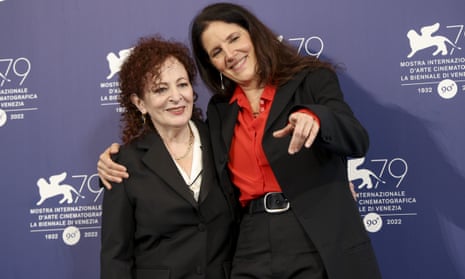A documentary about artist Nan Goldin’s fight to hold members of the Sackler family to account for the opioid crisis is “a challenge to other artists” to use their power to expose corruption, its director Laura Poitras has said.
The maker of lauded films including Risk (about Wikileaks) and Citizenfour (about Edward Snowden) was premiering All the Beauty and the Bloodshed in competition at the Venice film festival on Saturday.
The film examines the life and career of Goldin and her efforts to hold Purdue Pharma, owned by the Sackler family, accountable for the opioid epidemic.
Goldin, a photographer whose work documented LGBTQ+ subcultures and the Aids crisis, founded the advocacy group Pain (Prescription Addiction Intervention Now) in 2017 after her own addiction to OxyContin. The group puts pressure on museums and other arts institutions to end collaborations with the Sackler family, who have long been financial supporters of the arts.
“As a filmmaker who’s done political work, I have such respect for what Nan has chosen to do, to use her power and influence in the art world to demand accountability and to expose this really toxic philanthropy that we’ve seen with the Sackler family. But they’re not the only ones,” Poitras said.
“This film is a challenge to other artists or people who have positions of power: how do they or don’t they use that power? Here we have a legendary artist, who chose to risk her position in the art world to expose its corruption and the toxic philanthropy and whitewashing of blood money and institutions.”
Poitras said the failure of government to deal with epidemics in the US was “staggering”, as was the system that allowed a family like the Sacklers, and a company like Purdue Pharma, to “knowingly promote the drug that they knew to be addictive and to do that with the most egregious profiteering”.
Goldin made the connection between the opioid crisis and the Aids crisis of the 80s. “There’s 10 million people in the world that still have Aids … Aids phobia killed so many people, and it killed my community. And I don’t want to let another community die,” she said.
The opioid crisis has been linked to more than 500,000 deaths in the US over the last two decades. Last year, the Metropolitan Museum in New York announced that it would no longer display the Sackler name in its galleries, having joined other arts and education institutions in ceasing to accept donations from them.
Goldin added: “My proudest thing is that we brought down a billionaire family in a time when billionaires have a different justice system from the rest of us, and their total impunity in America. And we brought one down, so far.”
